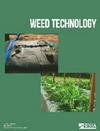Synergistic Interactions of 2,4-D, Dichlorprop-p, Dicamba, and Halauxifen/Fluroxypyr for Controlling Multiple Herbicide-Resistant Kochia (Bassia scoparia L.)
IF 1.7
3区 农林科学
Q3 AGRONOMY
引用次数: 0
Abstract
Multiple herbicide-resistant (MHR) kochia is a serious concern in the U.S. Great Plains and warrants alternative herbicide mixtures for its control. Greenhouse and field experiments were conducted at Kansas State University Research and Extension Centers near Hays and Garden City, KS to investigate the interactions of 2,4-D, dichlorprop-p, dicamba, and halauxifen/fluroxypyr premix in various combinations for MHR kochia control. Two previously confirmed MHR (resistant to glyphosate, dicamba, and fluroxypyr) populations and a susceptible (SUS) population were tested in a greenhouse study. Kochia at the Hays field site was resistant to glyphosate and chlorsulfuron, whereas the population at Garden City was resistant to glyphosate, dicamba, fluroxypyr, and atrazine. Results from greenhouse study indicated that 2,4-D, dicamba, dichlorprop-p, and premix of halauxifen/fluroxypyr provided 26 to 69% control of both MHR populations at 28 days after treatment (DAT). However, the control increased to 85 to 97% when these herbicides were applied in three-way mixtures. Synergistic interactions were observed when dicamba was mixed with dichlorprop-p, 2,4-D, dichlorprop-p + 2,4-D, and halauxifen/fluroxypyr + 2,4-D for shoot dry weight reductions (86 to 92%) of both MHR populations. Results from field study also indicated synergistic interactions when dicamba was mixed with dichlorprop-p + 2,4-D, halauxifen/fluroxypyr + dichlorprop-p, and halauxifen/ fluroxypyr + 2,4-D, resulting in 84 to 95% control of MHR kochia at 28 DAT across both sites. These results indicate that synergistic effects of mixing dicamba with other auxinic herbicides in two- or three-way mixtures can help control MHR kochia.2,4- d、二氯丙酯、麦草畏和氟虫腈防治多重抗除草剂小飞蛾的协同作用
多重除草剂抗性(MHR)曲霉菌是美国大平原地区的一个严重问题,需要替代除草剂混合物进行控制。在堪萨斯州海斯和花园城附近的堪萨斯州立大学研究和推广中心进行了温室和田间实验,以研究2,4-D、二氯丙-p、麦草畏和哈鲁昔芬/氟氧吡预混物在各种组合中对MHR曲霉菌的相互作用。在一项温室研究中测试了两个先前确认的MHR(对草甘膦、麦草畏和氟氧吡的抗性)种群和一个易感(SUS)种群。海斯农场的Kochia对草甘膦和氯磺隆具有耐药性,而花园城的种群对草甘膦、麦草畏、氟氧吡和阿特拉津具有耐药性。温室研究结果表明,在处理后28天(DAT),2,4-D、麦草畏、二氯丙-p和哈鲁昔芬/氟氧吡预混物对两种MHR种群的控制率为26%至69%。然而,当这些除草剂以三元混合物的形式施用时,对照增加到85%至97%。当麦草畏与二氯丙-p、2,4-D、二氯丙-p+2,4-D和哈鲁昔芬/氟氧吡+2,4-D混合时,观察到了协同作用,使两个MHR种群的茎干重降低(86%至92%)。现场研究的结果还表明,当麦草畏与二氯丙-p+2,4-D、哈劳昔芬/氟氧吡+二氯丙-p和哈劳昔芬/氟氧吡啶+2,4-D混合时,两个位点在28DAT时MHR曲霉菌的控制率为84%-95%。这些结果表明,麦草畏与其他生长素除草剂在两种或三种混合物中混合的协同作用可以帮助控制MHR曲霉菌。
本文章由计算机程序翻译,如有差异,请以英文原文为准。
求助全文
约1分钟内获得全文
求助全文
来源期刊

Weed Technology
农林科学-农艺学
CiteScore
2.90
自引率
21.40%
发文量
89
审稿时长
12-24 weeks
期刊介绍:
Weed Technology publishes original research and scholarship in the form of peer-reviewed articles focused on understanding how weeds are managed.
The journal focuses on:
- Applied aspects concerning the management of weeds in agricultural systems
- Herbicides used to manage undesired vegetation, weed biology and control
- Weed/crop management systems
- Reports of new weed problems
-New technologies for weed management and special articles emphasizing technology transfer to improve weed control
-Articles dealing with plant growth regulators and management of undesired plant growth may also be accepted, provided there is clear relevance to weed science technology, e.g., turfgrass or woody plant management along rights-of-way, vegetation management in forest, aquatic, or other non-crop situations.
-Surveys, education, and extension topics related to weeds will also be considered
 求助内容:
求助内容: 应助结果提醒方式:
应助结果提醒方式:


